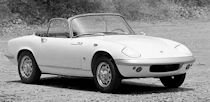Lotus 24 Race Car
 | |
Class | Race Car |
Constructor | Lotus |
Year | 1962 to 1964 |
Engine | V-8 Coventry-Climax |
Transmission | manual |
The Lotus 24 was a Formula 1 racing car , which was developed by Lotus in 1962 and used by various private teams until 1964.
History
Colin Chapman's first-announced the F1 Lotus 24 machine for 1962 withsteel multi-tubular frame with LOTUS 24 formula 1 was raced by the factory with Coventry-Climax FWMV V8 engine,and also by other teams and private entrants. UDT-Laystall raced the Type 24 with both Coventry-Climax and BRM V8, the latter engine also being used by Scuderia Filipinetti, Wolfgang Seidel, etc. Both power-units were equipped with Weber double-choke carburetters Coventty-Climax V8 engine. It was an advanced Grand prix car but also
Laystall's BRM-engined Lotus 24 with four Weber carburetters.
The Lotus 24 was basically an improved Lotus 21 with a tubular frame for the new 1.5-liter engine from Climax . Soon it turned out that the car for Lotus like its predecessor - was just an interim solution. Already at the Grand Prix of the Netherlands in the same year came the Lotus 25 , which should revolutionize the formula.
The front end of the 24 was voluminous and wide. 12 units were built by Lotus, seven of which had the Climax FWMV V8 engine and five the BRM V8 engine These cars were usually fitted with a 5-speed ZF-Lotus gearbox, but the factory "spare" car had a BRM V8 engine and 6-speed Colotti-Francis box during Monaco practice, and Taylor drove a special 24 at Brussels with a 5-speed Colotti-Francis box and Coventry-Climax V8 engine. The eight exhaust pipes, four on each side, jutted out of the rear of the race car almost vertically. Also in the workshop of Reginald Parnell Lotus 24 were completed under license.
A new multi-tubular space-frame Grand Prix car that was intended primarily for private owners and took the V-8 Coventry-Climax engine. It first appeared at the Brussels Grand
Prix in 1962. Among its successes when entered by the works were a win in the Lombank Trophy at Snetterton and the Aintree ' 200 ' by Clark and second place in the Dutch Grand
Prix by Trevor Taylor. Among purchasers of these cars were Jack Brabham, Rob Walker, Jo Siffert and the UDT-Laysta11 Team.
If the 24 was just a makeshift solution for the factory team, the private teams would certainly return to the car, especially Rob Walker (1962), the UDT Laystall team (1963-1964) and even the new team of Jack Brabham (1962). Racing drivers from Chris Amon to Rodger Ward drove the Lotus 24, including world champions like Jack Brabham and Phil Hill , the later team owner Roger Penske , the motorcycle world champion Mike Hailwood and the Frenchman Maurice Trintignant , who drove his first World Championship race in 1950.
Rating
Technical
-
Lotus 24 Technical details and specifications (1962-1964)
Chassis and suspension:
front and rear fully independent.
steel multi-tubular space-frame
front suspension by unequal length wishbones and coil spring/damper units mounted within the fibre-glass body panelling
rear suspension by reversed lower wishbones, single top links, double radius arms, coil spring/damper units, and anti-roll barBrakes:
Girling disc outboard on all four wheels.Dimensions:
wheelbase 91 in.
track front 51% in.; rear 51% in
overall body width 28 in.
overall length 144 in.
overall height 30 in.
dry weight 1,036 lb. approximatelyWHEELS TYRES:
tyre sizes front 5.00 X 15
tyre sizes rear 6.50 x 15CAPACITIES:
fuel tank capacity 27 gallons (Imp)
oil tank capacity 2 1/2 gallons (Imp)© Motor car History




